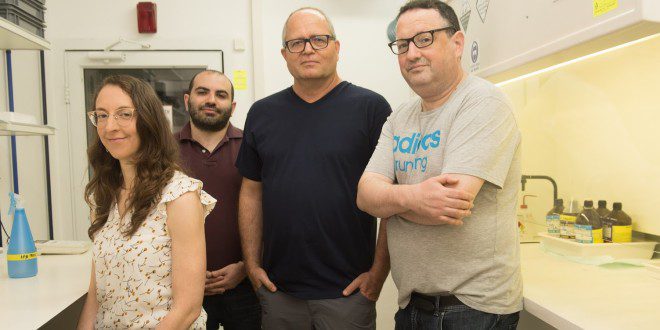The importance of solar energy to our lives is obvious. The sun transmits energy to Earth continuously, and if we are able to harness it for our needs, use of fossil fuels and pollutants such as petroleum and gas will no longer be necessary.
The main challenge in switching to solar energy lies in the varying availability of sunlight as the day progresses and seasons change. Every place on earth experiences sunlight for a limited period during the day, but naturally, there is no sunlight at night. Since the electrical grid needs a stable power at all hours of the day and night, use of solar energy depends on our ability to store it so that we are able to use it at night and on overcast days.
The problem is that the known form of electrical energy storage – batteries – can’t be used to supply electricity for a city, a neighborhood or a factory. In addition, the energy stored in batteries is adequate for a few hours, but batteries can’t provide a solution for long-term storage between seasons.
Prof. Avner Rothschild of the Faculty of Materials Science and Engineering at Haifa’s Technion-Israel Institute of Technology and Yifat Piekner, a doctoral student in the Grand Technion Energy Program have published a scientific breakthrough in their study of hematite in the journal Energy & Environmental Science under the title “Wasted photons: photogeneration yield and charge carrier collection efficiency of hematite photoanodes for photoelectrochemical water splitting.”
Ab important and promising material similar to rust, hematite can be used to convert solar energy into hydrogen using photoelectrochemical water splitting.
A possible solution to the storage problem is to convert solar energy into hydrogen using photoelectrochemical solar cells. These cells are similar to photovoltaic cells, which convert solar energy into electricity, but instead of producing electricity, they produce hydrogen using the electric power they generate. The power is used for photoelectrochemical water splitting – the use of sunlight energy to directly dissociate water molecules into hydrogen and oxygen.
The advantage of hydrogen over electricity lies is that the gas can be stored easily and used when needed to generate electricity or for other requirements, such as to power FCEVs (fuel-cell electric vehicles). In such cases, the fuel cell replaces the heavy, expensive batteries in Tesla cars and similar vehicles, and could also be used for residential and industrial heating, and the production of ammonia and other raw materials. The advantage of hydrogen as fuel is that its production and consumption do not involve greenhouse gas emissions, or any other emissions, other than oxygen and water.
One of the main challenges in photoelectrochemical cells is the development of efficient and stable photoelectrodes in a base or acid electrolyte, which is the chemical environment in which water can be efficiently split into hydrogen and oxygen. The photoelectrodes absorb the photons emitted by the sun, and use their energy to generate electronic charge carriers (electrons and holes, or missing electrons) that produce hydrogen and oxygen, respectively. Silicon, the semiconductor material used in photovoltaic cells, cannot serve as a photoelectrode of this kind, since it is unstable in an electrolyte.
This is the backdrop against which photoelectrochemical cells based on hematite photoelectrodes were developed. Hematite is an iron oxide that is cheap, stable and nontoxic and has properties that are suitable for water splitting.
But hematite also has its disadvantages, one of which is the gap between its theoretical energy yield and the yield achieved in practice in actual devices. For reasons that have not been clarified to date despite decades of research, the photon-to-hydrogen conversion efficiency in hematite-based devices is not even half of the theoretical limit for this material. By comparison, the conversion efficiency of photons in silicon solar cells is very close to the theoretical limit.
In the Rothschild team’s present research, it was revealed that the photons absorbed by hematite produce localized electronic transitions that are “chained” to a specific atomic location in the hematite crystal, thus rendering them incapable of generating the electric current used for water splitting – the separation of water into its elements, hydrogen and oxygen.
Using a new analysis method developed by Piekner with the help of her research colleagues, Dr. David Ellis of the Technion and Dr. Daniel Grave at Ben-Gurion University of the Negev in Beersheba, quantum efficiency in the generation of mobile (productive) and localized (nonproductive) electronic transitions in a material as a result of photon absorption at different wavelengths were measured for the first time.
Their separation allows for deeper understanding of the factors that influence the energy efficiency of materials for the conversion of solar energy into hydrogen or electricity.
Besides the achievement in terms of practical application, this is a scientific breakthrough that paves a new way for research into light-matter interaction in correlated electron materials.
The shortcode is missing a valid Donation Form ID attribute.




